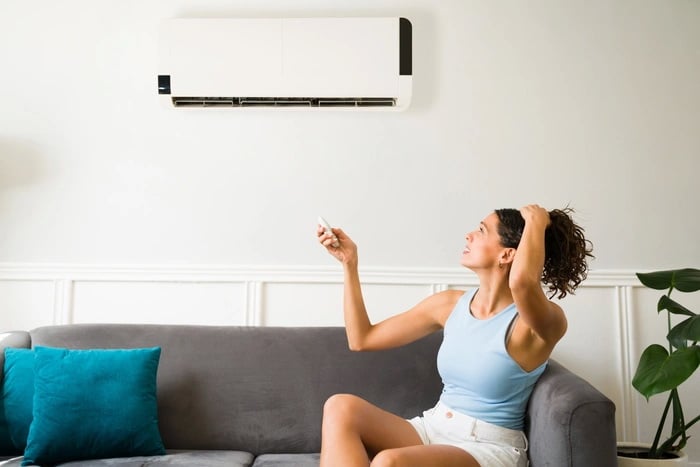On hot days, air conditioning is a “savior” to help us beat the heat. But using air conditioning continuously can affect the skin, nose or throat. In particular, the dry air in the room when using air conditioning can cause dry nose.
So how to improve and prevent dry nose caused by air conditioning?
1. Causes of dry nose when sitting in air conditioning
The main reason why we get dry noses when sitting in air conditioning is due to low air humidity.
The way air conditioning works is by blowing out cool but dry air. This means that if you spend a lot of time in an air-conditioned environment, your ears, nose and throat can become significantly dehydrated. This can dry out the mucous membranes in your middle ear and nasal passages.
The job of the mucous membrane is to help filter bacteria so they don't get into the inner ear and other parts of the body. If it doesn't work properly, bacteria can enter through the nose and end up in the deepest part of the ear thanks to the network of tubes that connect the two sides.
Thus, sitting in air conditioning for a long time not only dries out your nose but can also cause ear infections, dry throat and loss of skin moisture.
Low humidity is the reason why we get dry nose when using air conditioning (Photo: Internet)
2. How does dry nose affect health?
In addition to discomfort and pain, dry nose is rarely serious, but if left untreated for a long time, it can cause a number of problems such as:
- Irritates the nose and causes discomfort, creating conditions for bacteria, viruses, and molds to easily penetrate and cause diseases such as colds, flu, allergic rhinitis...
- Affects the sinuses, especially people with sinus will feel more pain and discomfort.
- Excessive dryness and irritation can cause the skin inside your nose to crack and bleed.
3. How to overcome dry nose when sitting in air conditioning
To overcome dry nose when sitting in air conditioning, people can apply some home remedies such as:
- Use a humidifier to add moisture to the air. This helps keep your nose, throat, and skin moist, preventing damage to these parts.
Note, when using a humidifier in a room, people should place the machine in an empty area with few objects to avoid making objects damp, causing damage or mold in the room.
- Drinking plenty of water will help rehydrate and keep your body moist. When sitting in air conditioning, you can drink small sips frequently.
- Steaming is also a way to help moisten the nose. To steam, you need to prepare a small basin of clean hot water, then bow your head and keep this position to breathe in the rising steam for a few minutes. You can also use a large towel to cover your head.
However, when steaming, keep your face about 20 - 30cm away from the water basin to avoid burns. Do not steam too much because if you overuse this method, it can make the dry nose worse.
- Using nasal spray helps to "lubricate" the mucous membranes, moisturize the nose as well as clean the nose, removing irritants from the nose.
Humidifiers will help increase humidity in the air and keep your nose and throat moist when using air conditioning (Photo: Internet)
4. How to use air conditioning properly to prevent dry nose
To prevent dry nose and other health problems when using air conditioning, people should note:
- Sit away from the air conditioner. Do not let your body or ear, nose, and throat area come into direct contact with the air from the air conditioner.
- Regular nasal irrigation can help keep the mucous membranes working well, protecting the sinuses.
- Use a humidifier or leave a bowl of water in the room when using air conditioning.
- The air conditioner temperature should be set from 26 to 29 degrees, not too low.
- If possible, you should only use air conditioning when the temperature is high. In the evening, when the temperature drops, you can use a fan or take advantage of the fresh air.
Source: PNVN
Source link







![[Photo] Prime Minister Pham Minh Chinh chairs the 16th meeting of the National Steering Committee on combating illegal fishing.](https://vphoto.vietnam.vn/thumb/1200x675/vietnam/resource/IMAGE/2025/10/07/1759848378556_dsc-9253-jpg.webp)



















![[Photo] Super harvest moon shines brightly on Mid-Autumn Festival night around the world](https://vphoto.vietnam.vn/thumb/1200x675/vietnam/resource/IMAGE/2025/10/07/1759816565798_1759814567021-jpg.webp)








































































Comment (0)